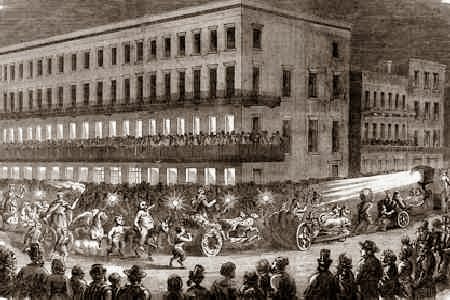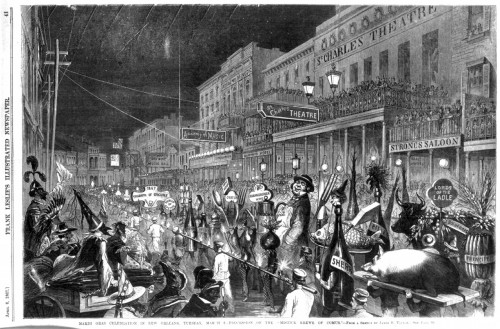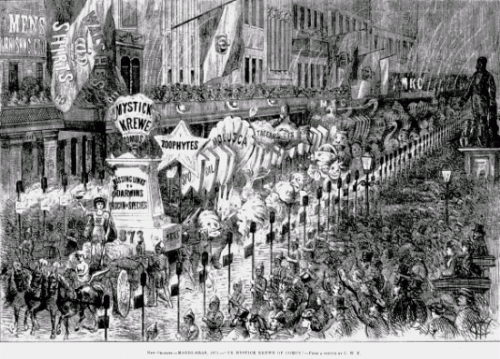New Orleans has been celebrating Mardi Gras since the 1730s, but it took a hundred years before we began to see street processions. The first processions included carriages and maskers on horseback. The first floats appeared in 1856 with the formation of the first Mardi Gras krewe: the Mistick Krewe of Comus.
Enslaved and free men of color lit the spectacles with torches. They were called the flambeaux. Eventually, they became a spectacle in themselves, dancing for tips. In the historical engravings below from the 1850s, you can see men carrying torches among the festivities (Wikimedia Commons and the Library of Congress).



Today, there are still flambeaux carriers and they are still mostly black men. The tradition has been passed down through generations. In a video at nola.com, a flambeaux carrier named Herbert Long explains that he’s been carrying flame for 18 years, following “generations of [his] family.” Today they carry kerosene torches.

Unbelievably, the first white men to carry the flambeaux appeared in a parade in 1969, something I’ll talk about tomorrow. Meanwhile, the first ever all-female flambeaux troupe, the glambeaux, debuted in 2014.

Today, the flambeaux are a beloved part of the Mardi Gras tradition, good and bad.
Lisa Wade, PhD is an Associate Professor at Tulane University. She is the author of American Hookup, a book about college sexual culture; a textbook about gender; and a forthcoming introductory text: Terrible Magnificent Sociology. You can follow her on Twitter and Instagram.
Comments 8
Mels — February 16, 2015
The image links in the middle set are all messed up; three of them show the same picture when enlarged.
Elena — February 17, 2015
"Enslaved and free men of color lit the spectacles with torches. They were called the [standard French word for "torches"]"
Why Are There So Many Mardi Gras Parades? | A Nerd's Guide to New Orleans — February 18, 2015
[…] The Krewe of Tucks was started by two white male Loyola students in 1969. They wanted to parade as flambeaux carriers — a nod to the original form of parades in which slaves or free men of color carried flames […]
Reamer Manuel — November 30, 2021
I admire your tremendous help that is quite updated to all and hope after getting the material on your blog we are able to explore. Thumbs up with dissertation literature review services work from the history truly like to grab the history update please continue sharing more.
googl — March 27, 2022
law dissertation writing service
Daniel Lisa — May 25, 2022
Thanks for your effort and for writing the content with pictures accordingly. Keep up writing the excellent content with dissertation proofreading services for the users to get help.
James Jordan — July 25, 2023
I am especially interested in how flambeaux started as a practical way to light up the night parades, but also reflected the racial and social issues of the time.
Best Home Remodeling Services Barrington IL
Maria Ward — February 25, 2024
I recently used Pangea Global Support for translation services, and I'm thoroughly impressed. Their team exhibited unmatched professionalism and attention to detail. The translations were not only accurate but culturally appropriate. The support team was responsive and went above and beyond to ensure my satisfaction. Pangea's versatility in handling diverse projects makes them my go-to for translation needs. Highly recommend https://www.pangea.global/game-localization-sevices/!